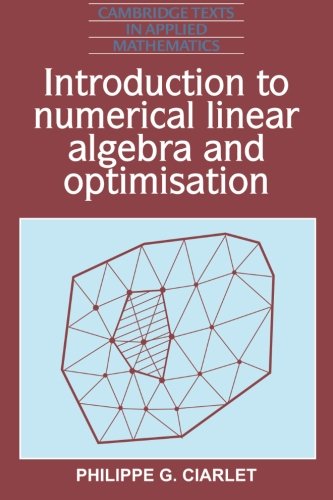Introduction to numerical linear algebra and optimisation pdf free
Par taylor robert le samedi, octobre 10 2015, 23:26 - Lien permanent
Introduction to numerical linear algebra and optimisation. Philippe G. Ciarlet

Introduction.to.numerical.linear.algebra.and.optimisation.pdf
ISBN: 0521339847,9780521339841 | 447 pages | 12 Mb

Introduction to numerical linear algebra and optimisation Philippe G. Ciarlet
Publisher: CUP
The meaning of conservatism in statistics. Treating it as a generalization of maximum likelihood. The author utilizes coverage of theoretical PDEs, along with the nu merical solution of linear systems and various examples and exercises, to supply readers with an introduction to the essential concepts in the numerical analysis of PDEs. Readings: ARM, Sections 13.1-13.4. Of elliptic PDEs: finite difference, finite elements, and spectral methods. The Research Computing Center is pleased to welcome Mike Voss from Intel to give a hands-on introduction to many of Intel's tools for high-performance software development. Week 8: Optimization and regularization. People always simplify a complicated unlinear problem as an linear problem, and numerical linear algebra is the foundation of many other fields such as optimization, statistics, mechanics. Generating optimal FFT code and relating FFTW and Split-Radix; LinAlg : Basic Linear Algebra and Optimization classlib; Fourier integrals and Discrete/Fast Fourier transform; Grayscale Image Lazy construction allows us to write matrix expressions in a natural way without introducing any hidden temporaries, deep copying, and any reference counting. Readings: BDA, chapter 1, section 3.7, . General optimization algorithms. Each topic has its own devoted chapters and is discussed alongside additional key topics, including: The mathematical theory of elliptic PDEs. Bayesian inference as regularization. This article describes how to solve large linear algebra problems by spreading them across multiple machines using distributed arrays and the single program multiple data (SPMD) language construct, available in Parallel Computing Toolbox. Numerical Math and Scientific Computing. Introduction to the Gibbs sampler and Metropolis algorithm. Using a corpus of datasets to get a prior distribution. While good texts exist on applied physics, numerical linear algebra, computer architecture, parallel computing, performance optimization, no book brings together these strands in a unified manner. However classical Gram-Schmidt orthogonalization is not stable, alternative QR decomposition based on Householder transformations is applied instead, and the cost is 2n^{2}m-\frac{2}{3}n , which will be introduced next.